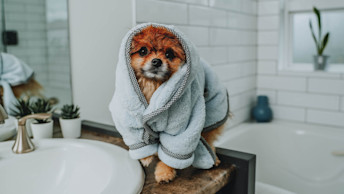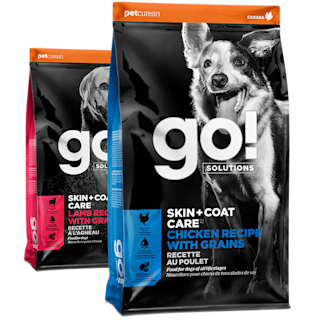January 20, 2022
How to Groom Your Dog at Home

As most of us who are owned by dogs know, hound grooming is central to keeping them looking, being, and feeling in top health. As dogs make their way through their day, walking, running, mixing it up with their neighborhood pals and investigating new patches of ground, they’ll pick up not just dirt, but also hitchhikers like thorns, burrs and more pernicious travelers, like fleas and ticks.
Simultaneous to daily outings is the growth of their fur and nails. Thus, your four-legged amigo periodically requires some extra TLC beyond daily feedings and love – in the form of regular full grooming.
Why good grooming matters
With all the demands of work, family and social life, it’s easy to put off grooming, or resort to half-measures. But not grooming sufficiently can harm a hound’s health and general happiness. Plus, grooming needs left unattended have a way of becoming unpleasant and expensive to deal with later on.
This explains the number of businesses that will groom your dog for you. But given the time and expense of running their dogs to the groomers and back, a lot of people are taking matters into their own hands. And they’re finding it not merely economical, but also a satisfying bonding ritual. After all, to a dog, time spent with the human they manage is quality time, no matter what the activity.
Here’s our guide to becoming a master home groomer
We’re going to show you how to groom your dog correctly and safely at home.
First, you’ll need the following:
- Dog Brush
- Dog nail clippers
- Towel
- Scissors
- Hair dryer
- Shampoo for dogs
- Cloth
- Cotton balls
- Dog toothbrush
- Dog toothpaste
- Nose and paw balm
Bathing that canine
Depending on dog size and temperament, choose your bathing venue, whether sink, wash basin or bathtub. You can wear rubber gloves if you like. First, gently wet your dog’s fur with warm water (a bucket and scoop work a charm if you lack a shower hose and nozzle). Once poochiekins is good and soaked, squirt a good lick or two (proportionate to surface area) of shampoo into the fur, working it in, keeping suds off face (dog’s and yours), massaging until you get a good lather everywhere. Have an eye peeled for any plant and parasitic freeloaders.

While you’re at it, check bum and genital regions to make sure they’re squeaky clean and free of unwanted, um, hangers on. Once you’re satisfied that all is well shampooed, gently rinse off suds with warm water, taking care to generously sluice belly and nether regions of soap. Now dry off that dog with a thick towel or, for long-haired or style-conscious animals, a blow dryer.
How often should you wash your dog? Once or twice monthly generally does it, unless yours has waded into a swamp, or had a roll-around in something gross.
Brushing and trimming your dog’s coat
You’ll want to brush his coat a few times a week, minimum, to keep it looking fresh and to keep shedded hair off you and your furnishings. We recommend daily brushings for more furry dogs. You may opt to take that outdoors. Regular brushing shakes dirt away and de-tangles long fur, preventing matting and dreads, and keeping that coat shiny and smooth.
Looking for a remedy to your dog’s itchy skin or dull coat? Try a month or two on our Go! Solutions Skin + Coat Care recipes. They taste fabulous and contain the omega fatty acids needed to support healthy, hydrated skin and a shiny coat.

Recommended Solutions
Skin + Coat Care Recipes for Dogs
Full of Omega-3 fatty acids to hydrate skin, help prevent dandruff and reduce shedding
Skin + Coat Care™ Recipes
Trimming your canine
You’ll also want to break out the dog scissors to trim off excess fur. Remember to trim in direction of hair growth, starting from the neck and working your way down. For super furry animals, it’s good to keep the hair well-trimmed around the bum zone to avoid unwanted “stalactites”. Just be super extra careful in these sensitive areas.
Cleaning eyes, ears, nose and paws
To clean away sleep, wax and such, use a water-dampened cloth around the eyes and under the ear flaps. Check for parasites in/around these areas and use moistened cotton balls to clean inside the ears. If baby’s nose is dry and chapped, add a little nose balm. Similarly, for dry or rough paws, massage in some paw balm. They’ll thank you for it next time you shake that paw.
Dental care is a thing
If your dog has less than fragrant breath or teeth that aren’t quite pearly white, gently brush those ivories clean with a regular soft toothbrush and our special dog toothpaste.
Check out our Dental Care for Dogs blog.
Last but not least, trimming nails
If your dog has long or too-sharp nails, use dog nail clippers to take the edge off. It won’t cause them pain as long as you take care to just snip off the tips, avoiding the blood vessels, which you can see through the nail.
How do you know when your dog needs grooming?
Depends on the breed and size and how dirty that lad or lassie gets on daily walks and play sessions. Common sense is usually your best guide. Whatever regimen you adopt, be sure to only use products for dogs, not human shampoos or other people-cleaning products. Those regular grooming sessions will keep your beloved clean and healthy, and looking the part.
Plus, there’s no better way, short of feeding time, to show your love to the boss.


